Sharing the season on Sourdough
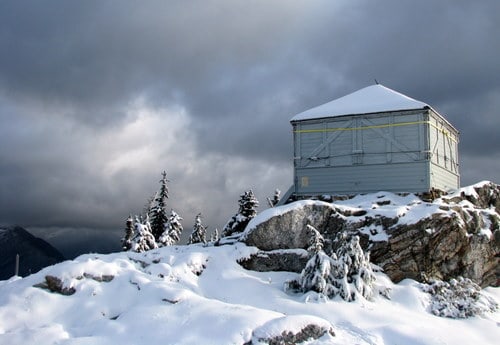
By now, the wind chill has reached the low 20s. A crisp, fall breeze pierces my cheeks and sinks deeply into my exposed fingertips. It is finally time to put on the winter gloves.
Only the 3rd of October, it is the earliest of the fall season I have felt the fleece lining I so often associate with the dead of winter. Those familiar with the climate and topography of the North Cascades would say that, on a north-facing slope at nearly 6,000 feet in the fall season, these conditions are to be expected. Expected or not, the stark contrast in temperature change never fails to shock me.
The trail has all but disappeared as we near the summit of Sourdough Mountain. Camouflaged, in part, by a fresh coat of snow, as well as by the grayish-white color of its outer paint layer, Sourdough Lookout – today’s destination – appears like that of any animal in survival mode, evolved to change its colors to match that of its wintry surroundings. We, on the other hand, are a mixture of bright orange and black, Adidas tennis shoes and mountaineering boots, baseball caps and old, woolen hats from the early ‘80s climbing era. With a jar of peanut butter, a few whole grain tortillas, and some apples and cheese, we were evolved to seek adventure, by any means possible, in any way possible.
For those of us living in the Pacific Northwest, we come to these wild places to seek our adventures. At least those of us who know how to access the North Cascades. Recently situated at the Environmental Learning Center, one of the most rewarding aspects of being a graduate student here and having my backyard leak into these wild places is sharing it with those I care for who have never before had the chance to seek such an adventure.
It seemed appropriate, then, that when my friend Daryl came to visit, I should introduce him to my new home in the North Cascades through an adventure he would not soon forget.
In all trail guides, Sourdough Mountain is known as a thigh-master extraordinaire. The first few miles are a steep gain of nearly 3,000 feet along a hillside coated in a variety of ecosystems – wind-blown Lodge pole pine stands, fragile in the fall winds, small creek drainages coated in moss and strewn with vine maple, Douglas firs too big around to fully hug. We left the trailhead at 12 noon, and with many route descriptions averaging a hike time of 9 hours, we weren’t sure if we would reach the summit, but we did not let that deter us from attempting.
After finally establishing a sustainable rhythm a few miles and several thousand feet of elevation gain into the hike, we began to see the changes so often associated with the fall season. Vine maples are great indicators of seasonality. As we progressed, their leaves had changed from a soft green to mixtures of vibrant yellow-green and deep red-orange. It was blinding to the eye against a backdrop of dark evergreen and brown. Salal, one of the Northwest’s most common understory shrubs, lined the trail for quite some time. The shrub’s purple berries were plump and plentiful as I grabbed a handful every few minutes to help maintain my energy.
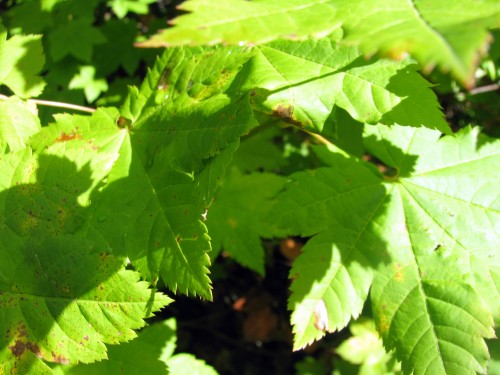 Speckled vine maple leaves indicate the changing of seasons
Speckled vine maple leaves indicate the changing of seasons
Over half-way to the summit, the winding switchbacks eventually ease and the transition from summer to fall becomes even more defined. Dozens of Russula and Bolete mushrooms push their way out from beneath the soft soil along the trail side. You can hear the chatter of Douglas squirrels feasting on fir cones. The transition to Subalpine also becomes more apparent. Western hemlocks and Douglas firs give way to Subalpine fir and black huckleberry and blueberry bushes. Neighboring Davis Peak looms over us to the west, its southeastern ridge line defined as it extends upward toward its summit. As we hike higher, glimpses become a full-on panoramic of my familiar friends, Pyramid and Colonial Peaks.
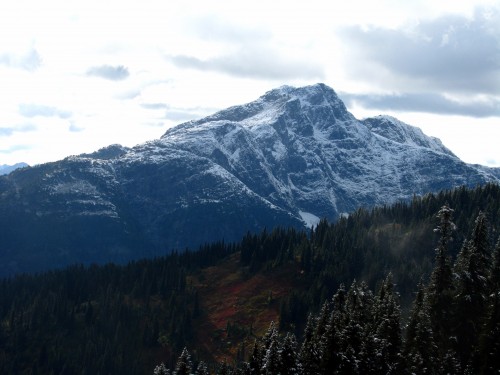 Davis Peak’s sheer face is a reminder of this trail’s plentiful elevation gain
Davis Peak’s sheer face is a reminder of this trail’s plentiful elevation gain
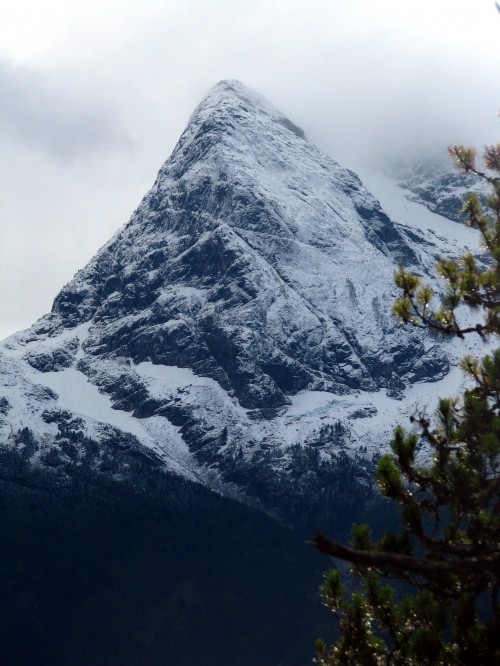 Views of Pyramid Peak become clearer as ecosystems transition
Views of Pyramid Peak become clearer as ecosystems transition
And snow. As we traverse closer to Sourdough Creek, the colors of fall are cloaked in the illusion of winter as we touch our first snow of the season. It may only be an inch in thickness, but the chill surrounding us is overwhelming – alien, almost, to the world so different several thousand feet below. It comes as no surprise that even underneath the snow, specks of color immerge. Mountain blueberries. Their Latin name, Vacinium deliciosum, describes perfectly their fullness and ripe nature. Daryl points out a large bluish-purple mass in the middle of the trail. Scat. Bear scat, composed completely of berries. Our friend has the same idea as us. It is evolved to eat these berries, in order to become fat enough that it will survive hibernation during the coming winter. We are evolved to eat these berries, so that our energy will take us all the way to the summit, so that our adventure seeking instinct will be satisfied.
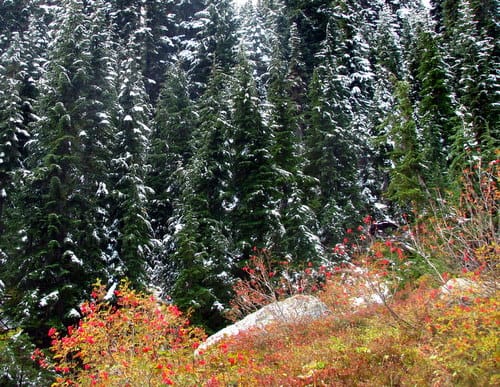 Hints of both fall and winter are evident in a single landscape
Hints of both fall and winter are evident in a single landscape
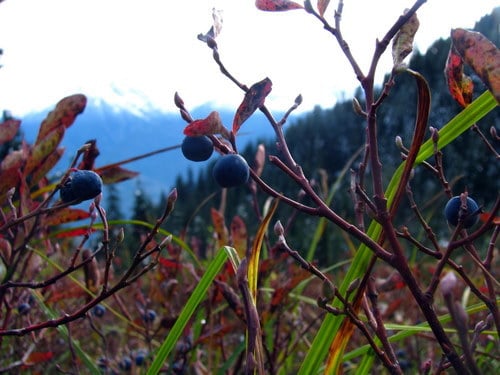 The famed Mountain blueberry, found in the higher reaches of the North Cascades
The famed Mountain blueberry, found in the higher reaches of the North Cascades
Crossing Sourdough Creek, the trail immediately again gains steepness for the final mile and a half. Even on this south-facing slope, covered mostly in blueberries, last night’s snow is thick enough to make navigation interesting. With the help of various animal tracks, however, we make our way, slowly and slickly, up the trail.
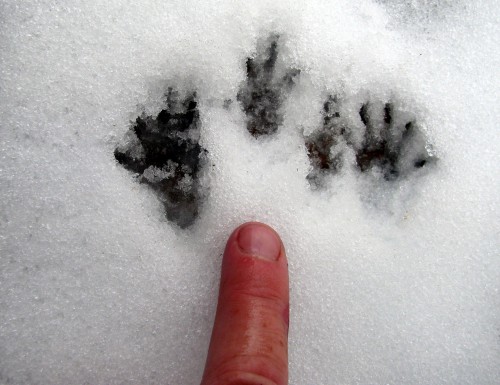 The first set of tracks seen head in the direction of the summit
The first set of tracks seen head in the direction of the summit
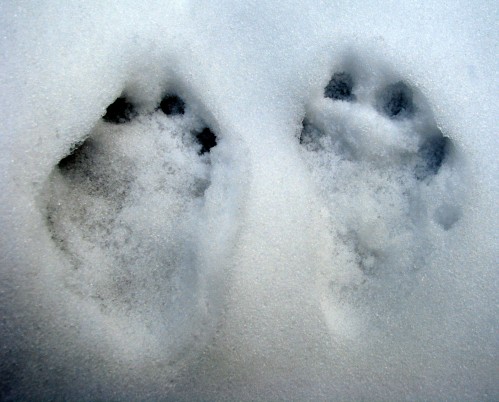 At least three different sets of tracks were spotted on one small stretch of trail
At least three different sets of tracks were spotted on one small stretch of trail
All afternoon, I had been watching the weather. Sourdough Mountain is a fantastic location to observe different climatic patterns, as four major river drainages radiate from its base. A thick, low-lying cloud mass had been creeping ever so quietly down the Thunder Creek drainage to the south, as if to eventually devour the turquoise waters of Diablo Lake below.
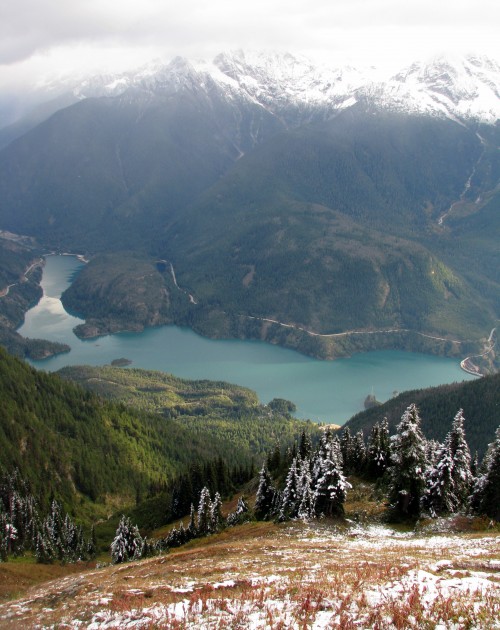 A carpet of blueberries and fresh snow gives way to Diablo Lake below
A carpet of blueberries and fresh snow gives way to Diablo Lake below
The clouds occupying the Skagit River’s western waterway remain complacent with no desire to change. As we transition from south-facing slope to north, the Ross Lake region reveals itself. Even from this distance, looking north, the dry, eastern shoreline is evident. The presence of ponderosa pine and other vegetation more commonly associated with eastern Washington reminds me of a rain shadow’s presence, created by the Pickett Range in the west.
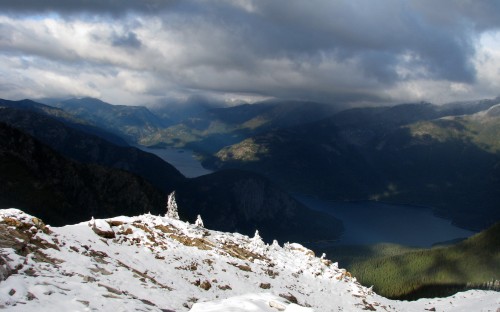 Ross Lake’s drier eastern edge contrasts with Sourdough’s snowy north slope
Ross Lake’s drier eastern edge contrasts with Sourdough’s snowy north slope
The trail now has all but disappeared. No other human footprints have traveled here since the snow had first hit. Small and infrequent indentations in the white layer hint to us where the trail probably is, so we follow it, at times punching through an extra thick layer that brings snow level up to mid-calf. Cresting a small knoll, Sourdough Lookout reveals itself, only a few hundred feet away. Daryl shouts out a loud, “Hello!†in hopes it would echo across the valley. His call sparks in me a vivid image of Gary Snyder atop the Sourdough Lookout, reciting his poetry through both space and time, to Jack Kerouac on Desolation Lookout in the northeast.
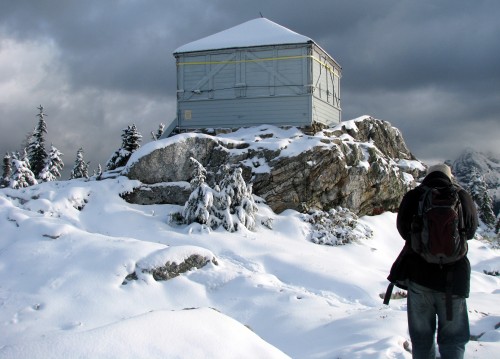 Daryl approaching the Lookout
Daryl approaching the Lookout
Upon reaching the summit, we spend only a few minutes admiring the view. Down jackets and a quick snack help warm us, as the fierce wind chill tries to bring down our core temperatures. I take in 360 degrees of wildness. I take in a deep breath.
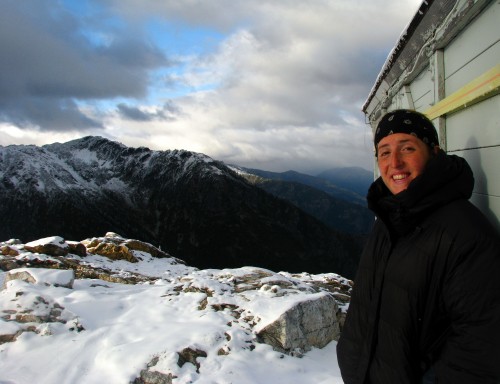 The author atop Sourdough Mountain
The author atop Sourdough Mountain
These wild places are special not just because of their wildness, but because of how wildness ties into everything else here. They are home to plants, to insects, to mammals, to amphibians, to invertebrates, to trees, to fungi, to microscopic bacteria. They are the shelter, the water, the food, and the relationships. They are not just habitat. They are the inspiration and the adventure to hikers and backpackers, to climbers and poets, to those who dream, to those who at least try.
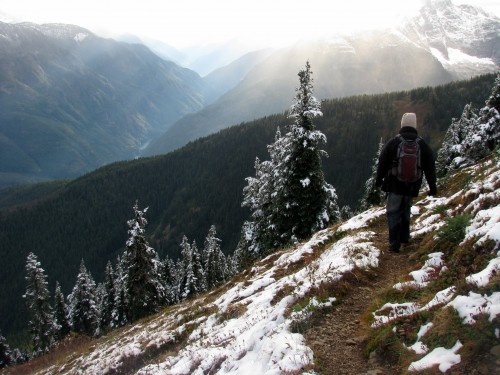 Hiking down from the summit with the fall sun low in the horizon
Hiking down from the summit with the fall sun low in the horizon
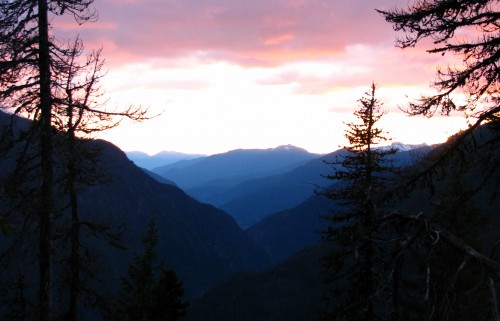 A sunset down the Skagit Valley is a perfect ending to an alpine adventure
A sunset down the Skagit Valley is a perfect ending to an alpine adventure
To Daryl, Sourdough Mountain is a welcoming host, his introduction to the challenges and discoveries of the new fall season in the North Cascades. To me, this mountain is a reminder to share this place I love with those I care for – and to always seek adventure, by any means possible, in any way possible.
Photos courtesy of Kelsi K. Franzen.


Kelsi,
Stunning photos. I know views like these are a dime a dozen in the North Cascades, but we can’t all live up there. Thank you for sharing a view of home. Did you make it down before dark, or did you two finish off the day with a night hike?
Peace, Love & Bar-B-Q Sauce,
Ben
Great story and photos Kelsi, nice job introducing yourself to Chattermarks. I look forward to reading more about your adventures in the North Cascades!
hey Kelsi this is awsome I loved it….It was a great adventure and one i will remember forever. Thank you for taking me.
What a joy to read and a great story to share – thanks for the beautiful photos and congrats on your first Chattermarks blog. Looking forward to more adventures in the future! Love and hugs-Mom
That was wonderful, Kelsi. These pictures have made me determined that I must climb this beast of a trail again with you, and actually make it to the top. :o)
Great article, lot’s of feeling, and the photos are amazing. I look forward to reading more of your writings. I hope to meet up with you soon and have a personal tour of your new home.
Great blog post Kelsi! The snow adds to the adventure and the beauty.
I love it. Nice post, great photos, well done.
what a beautiful story about such a beautiful place !!
Great job, makes me wonder, not for the first or last time, why anyone would want to live in a city.
Pretty good for a “crack of noon” start! Just thinking about the trip down to beat the darkness makes my knees hurt. Your testimony to the value of such adventures is eloquent and the pictures are terrific. This is an exceptional fall for color. The larches over at Washington Pass are shining brightly, so get there before the coming storms knock them off. Great job, Kelsi!
Enjoyment!- your story unfolds naturally like a backcountry trail. Curious animal tracks, have you since investigated your trail friends? How are the legs?- That’s pert near 10,000 feet elevation change! I look forward to more- keep up the good work!
Kelsi, it’s great reading about the good times you’re having at the Institute. Your mom is really proud of your work and knew I’d be interested.
Stay well!
John
Kelsi, Just now reading this. I have enjoyed the lavish descriptions of the adventure you shared on Sourdough. I loved reliving the hike in your words in spite of the gastroc griping memories. I tend to relate this climb to the Candyland game, from lodge pole pines to lush mosses. My inspiration to the challenges in elevation were found in the plentiful blueberries in August. Many made it back to make muffins in Kentucky. Tame weather was encouging but, our visit to the panoramic view at the lookout and with the alpine flowers was too brief. Thank you for sharing your words and pictures of fall in this awesome area. It is a gift for adventurers.
Carolyn’s Mom